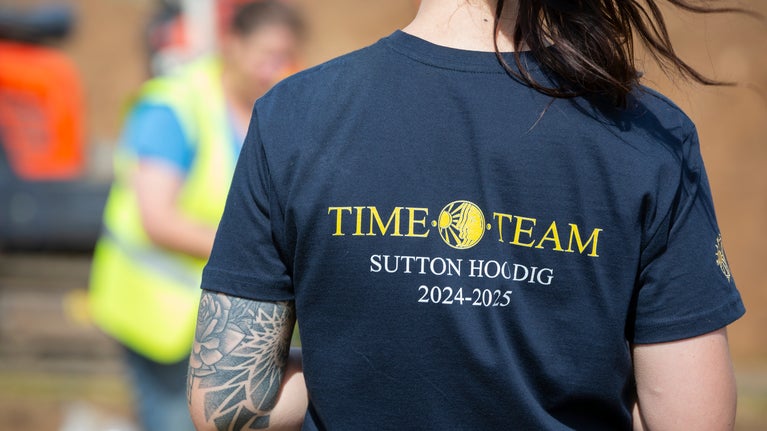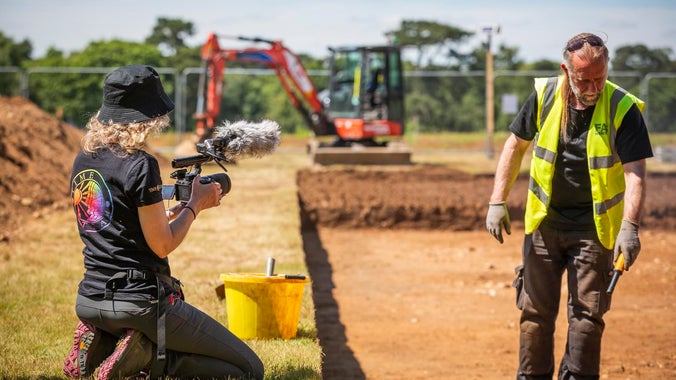
Discover more at Sutton Hoo
Find out when Sutton Hoo is open, how to get here, things to see and do and more.

Catch up with the latest news from the National Trust's two-year research project with Time Team.
This year's Time Team dig has come to an end. Digging took place between Monday 19 May and Saturday 15 June 2025, with archaeologists, film crews and volunteers all returning to Garden Field to continue their investigations.
We'll be keeping this page up to date with any news, but in the meantime, you can watch Time Team's latest live recordings on their YouTube channel or read on to discover more about the amazing discovery they made in 2024.

Time Team returned to Sutton Hoo in June 2024. Working in partnership with the National Trust, FAS Heritage and over 80 volunteers from all over the world, they dug test pits, excavated and metal-detected Garden Field, in what was the most intensive period of excavation at Sutton Hoo since the 2000s.
The hero find was the base of the 6th-century Byzantine Bromeswell bucket, which was lifted in a single block and sent away for further analysis under laboratory conditions. It was unknown how much of the bucket would be intact or what it might hold, but it was later revealed to be completely intact and to have held a cremation burial and grave goods.
The block was scanned using computerised tomography, 'CT', and X-rayed at the University of Bradford, which is where the base of the bucket and its contents were first revealed. Funded by Time Team’s Patreon supporters, it was then sent to York Archaeological Trust for micro-excavation.
The cremated human and animal bones uncovered confirm the find was used as a cremation vessel.
Cremated human bones included parts of a talus (ankle bone) and fragments of a skull vault (the upper part of the skull that protects the brain). They are now being analysed by specialists to understand the cremation process and determine what was on the funeral pyre.
Horses were often included on early Anglo-Saxon cremation pyres as a sign of status, and the animal bones indicate they belong to an animal larger than a pig.
Further tests reveal that, due to the tightly packed positioning of the cremated bone, it's possible that it was originally contained within a bag. Although the burial remains were clearly disturbed when the first fragments were found in 1986, copper-alloy staining on this bone indicates it might have been originally buried outside of the bucket.
Angus Wainwright, National Trust archaeologist, said: “We knew that this bucket would have been a rare and prized possession back in Anglo-Saxon times, but it’s always been a mystery why it was buried. Now we know it was used to contain the remains of an important person in the Sutton Hoo community. I’m hopeful that further analysis will uncover more information about this very special burial.”
Time Team osteoarchaeologist Jackie McKinley has also selected some of the cremated bone from within the bucket for radiocarbon dating, which could give valuable insight into how this rich grave helps in understanding the Sutton Hoo story.

A mystery object on the scans was also revealed to be a double-sided comb, probably made from antler, that had not been burnt.
Antler and bone combs have been found in both male and female burials, which suggests that personal appearance and grooming was important to the Anglo-Saxons. Slightly less romantically, combs also would have been useful in the control of lice.
Although the human bone in the cremation couldn’t be sexed, it’s hoped that ancient DNA from the owner might survive on the comb, and analysis could reveal more about them.
Fragments of the bucket, which may have been a diplomatic gift or acquired by a mercenary Saxon soldier, were first uncovered at Sutton Hoo in 1986, with further pieces unearthed in 2012. Visitors can see the main fragment on display at Sutton Hoo, on long-term loan from the Annie Tranmer Charitable Trust. It is decorated with a hunting scene, with men armed with swords and shields, and animals including lions and dogs. The latest fragments include feet, paws, the base of shields and even the missing face of one of the men.
Letterforms used within the bucket’s design suggest it was made in the 6th century, meaning it was already a hundred years old when it arrived here at Sutton Hoo. It's thought to have originated from Antioch in modern Turkey, which was then part of the Byzantine Empire.
Helen Geake, Time Team’s Anglo-Saxon expert, says: “We’ve finally solved the puzzle of the Bromeswell bucket – now we know that it is the first of these rare objects ever to have been used in a cremation burial. It’s a remarkable mixture – a vessel from the southern, classical world containing the remains of a very northern, very Germanic cremation. It epitomises the strangeness of Sutton Hoo – it has ship burials, horse burials, mound burials and now bath-bucket burials. Who knows what else?"

Time Team have been documenting this unique investigation as it's unfolded, sharing regular updates on their YouTube and social media channels. The most recent updates can be viewed here.
Full details of the coverage and documentary release dates for the 2025 dig will be confirmed in a future announcement.
The research project complements a separate, ongoing Time Team documentary, already in development, filming the Sutton Hoo Ship’s Company’s reconstruction of the ship at the centre of the site’s story.

Find out when Sutton Hoo is open, how to get here, things to see and do and more.